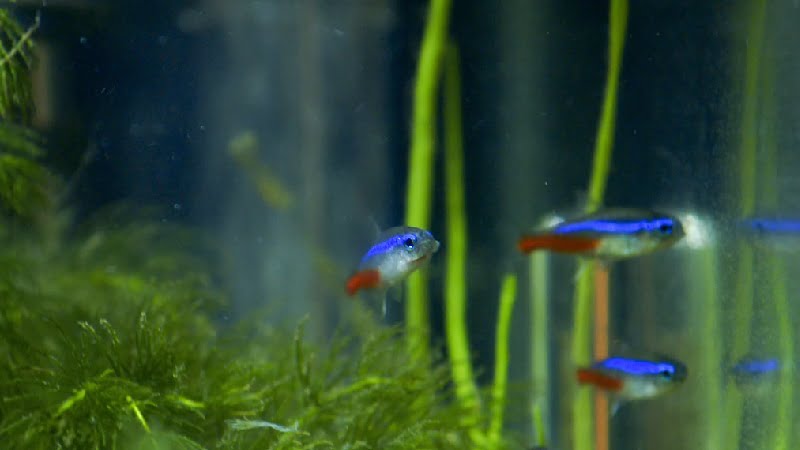Neon tetra fish is one of the most popular freshwater aquarium fish. They are easy to care for and have a beautiful iridescent color that can brighten up any tank. There are five different species of neon tetra, each with its own unique coloration. Let’s take a look at the different Neon Tetra fish colors and their meanings.
Prominent Neon Tetra Fish Colors Species
This section will help you learn more in detail about how various neon tetra colors are and how to take care of them.
Gold Neon Tetra
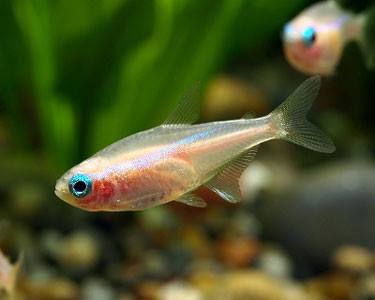
The body of the Gold Neon Tetra has a combination of red and silver coloration. There are blue eyes that protrude from the body. This is leukemia. There is a translucent, silvery-peach color to the body. From its snout to its tail, its body is marked with a red-gold line. A red edge is visible on the dorsal fin, but a white edge is visible on the anal and pelvic fins. A small fish can reach a length of 16 inches.
The Gold Neon Tetra is a peaceful and easy-to-keep fish. Their colors can be paired well with neon tetras, cory catfish, and a variety of barbs and danios. Six or more gold neon tetras are ideal for your tank keeping.
The pH level of their water should be between 5.8 and 7.5. It is best to keep them in a rectangular tank with a volume of 15 gallons or more. They survive at a temperature of 24 to 28 degrees Fahrenheit. In addition to eating live food, Gold Neon Tetra eat flakes and frozen foods and food at the bottom of their aquarium. You should feed them frequently but in small amounts.
Price: The fish cost between $2 and $3 each.
Black Neon Tetra
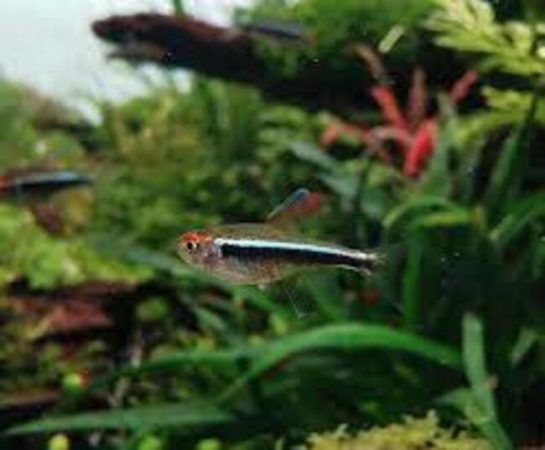
Black Neon Tetras are often known as black neons. People appreciate this fish because of its resilience; it can adjust to a wide range of changes in water conditions. It has a one-of-a-kind look. Above its large eyes is a semi-circle of orange. There are fine horizontal lines from the gill cover to the caudal fin. One line is black, the other is bluish-white, their entire body is greyish brown, and they have some shimmering yellowish and greenish markings.
Like other neon tetras, Black neon tetras should be kept in groups of at least 6. Because black neons swim at the water’s surface, we may also maintain some little fish that swim at the middle or bottom of the water. They are gregarious creatures and may readily coexist with other tiny fish in the communal tank.
It thrives best at temperatures between 24 and 28 degrees Celsius. While high-quality flake or pellet food is suitable for them, it has a better chance of sustaining them if you also feed them freeze-dried bloodworms and brine shrimps. The ideal tank size for black neon tetras is a 20-gallon one. Black Neon Tetras need a pH value of less than 7.5 to thrive.
Price: They are approximately $2-$3.
Diamond Head Tetra
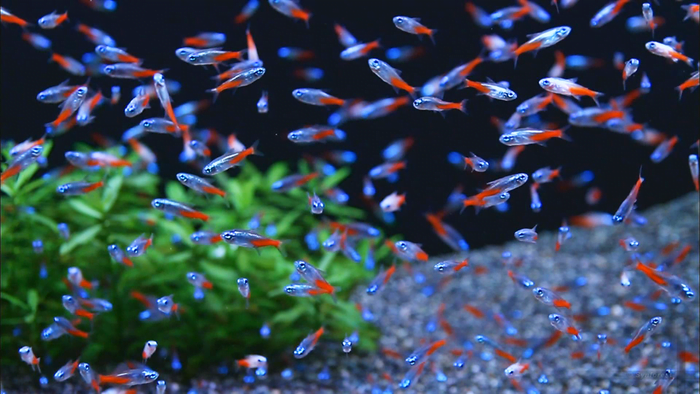
Diamond Head Tetras feature a diamond-shaped patch on their back, between their eyes, and a selectively bred dorsal fin. The majority of consumers purchase fish while they are young, and they like brightly colored baby fish. When diamond head tetras are young, their color is dull. Therefore they are frequently overlooked by aquarium owners. However, their shimmering body gives them a gorgeous look when the fish mature. The body of this tetra species is striped horizontally in blue and red. They can reach 2.5 inches in length.
Their temperament is peaceful, and they require reasonable care. We should use tall plants in the aquarium since they are medium-level and high-level swimming fish. Groups of six to ten fish should be sufficient.
Tetras with diamond heads eat micro pellets, small shrimps, flakes soaked in high-quality liquid food, and freeze-dried bloodworms. Usually, they live at temperatures of 20-26°C and a pH of 4-8. Tank sizes should not be smaller than 10 gallons.
Price: This fish ranges from $2 to $8, depending on the geographic location.
Red Neon Tetras
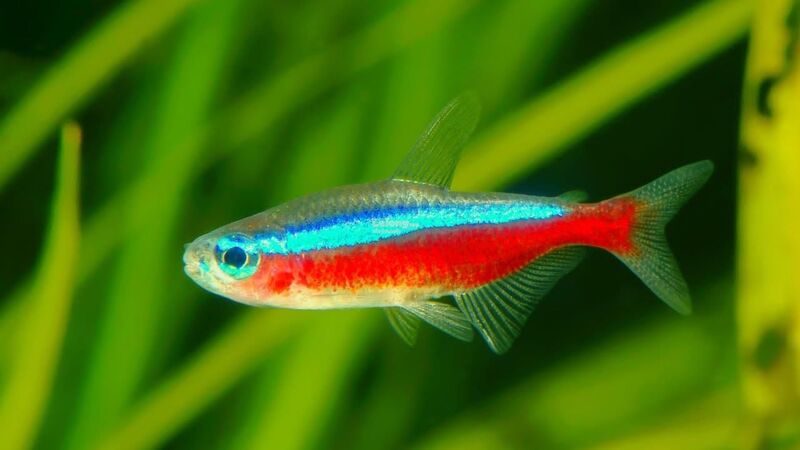
It is often misunderstood that red neon tetras are the same as true neon tetras, as they seem similar in appearance. True neon tetras grow to 2 inches in length, but red neon tetras can grow to 2 inches. From its eye to its tail, Red Neon Tetras have a blue stripe, below which is a red stripe extending from its head to tail.
Schooling with similar small fish is a peaceful and social experience for these little fish. Other potentially compatible fish include danios, rasboras, and smaller neon tetras. These fish are mainly found in the middle of the water column. Aquariums with moderate lighting, an adequate swimming space, and well-planted aquariums are ideal for red neon tetras.
When it comes to red neon tetras, a temperature of 23-27°C is ideal, and a pH of no more than 6 is unsuitable. You should also avoid frequently changing the water chemistry. You should maintain a minimum of 10 gallons.
Price: They cost about $3 to $4. They are a little more expensive than real Neon Tetras.
Green Neon Tetras
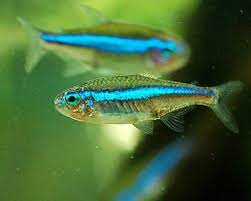
The green neon tetra is sometimes referred to as the blue neon or false neon. Have you ever wondered why the name is so popular? Often, people confuse green neon tetras with their relatives, the true neon or cardinal neon tetras. The lower part of their bodies is a faint red color (horizontally; like neon tetras), while the upper parts are a beautiful greenish-blue color. They also have green heads and backs.
The green neon tetra is short-lived and lives between two and three years. The tiny size of these fish makes them ineffective community fish, even though they are peaceful fish. You should keep these fish alone and in groups of at least eight or a tank no smaller than 30 gallons.
Insects, larvae of mosquitoes, and crustaceans are among the live foods these omnivores consume. Their natural temperature ranges between 24°C and 35°C. An ideal pH level would be 3.5-6.5.
Price: They range between $4 and $7.
Do Neon Tetras Change Color?
Neon tetras are typically a silver color with a bright neon blue stripe running down their backs. However, some neon tetras can change color depending on their environment and diet. For example, if a neon tetra is kept in a dark tank, its colors will become less vibrant. If a neon tetra is not getting enough food, its colors will also fade.
According to the research, freshwater fish neon tetra changes the color of their lateral stripes when the light conditions change from blue-green in the light-adapted state to indigo in the dark-adapted state based on changes in light conditions. Two colors are produced as a result of constructive interference between light reflected from intracellular guanine crystal stacks. The diffraction pattern associated with each crystal array within a single cell during color change has been traced using micro X-ray diffraction. Neon tetras are not difficult to care for, but they require a lot of attention if their coloration remains vibrant.
Video: 8 Most Popular Neon Tetras Varieties
FAQs
Are neon tetras naturally colored?
Fluorescent and neon fish are created artificially by injecting fluorescent materials into them, but natural fluorescent fish do not exist.
How do neon tetras change color?
It may take several hours to see the neon tetra fish change color. The time it takes depends on how long the fish is exposed to light at a particular time.
Are neon tetras injected with dye?
No, they haven’t been dyed.

Annette M. Chaney is an experienced marine biologist with over 20 years of experience as an aquarist and fishkeeper. She started her first aquarium at a young age, filling it with frogs and goldfish obtained from the ten-cent pet store.
Annette grew up caring for and breeding African Cichlids, which led to a hobby in high school that doubled as a profitable means. Attending Reed College gave her time to solidify herself as an accomplished aquarium caretaker with an eye for sales. After that, from 2009 – 2013, she studied at Roger Williams University – one of the most prestigious universities for Aquaculture and Aquarium in USA. She is the founder of AquariumCircle since 2010.
